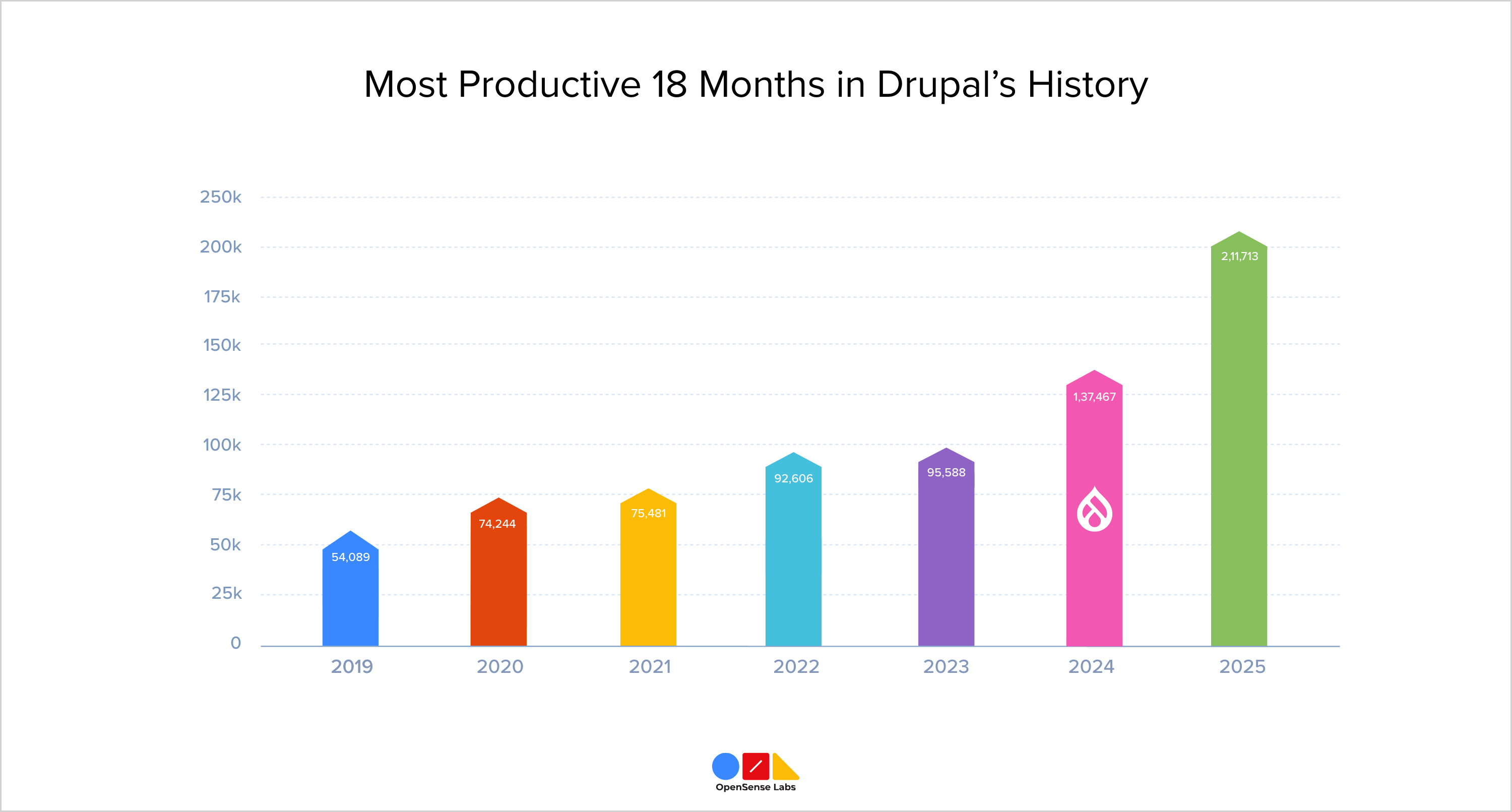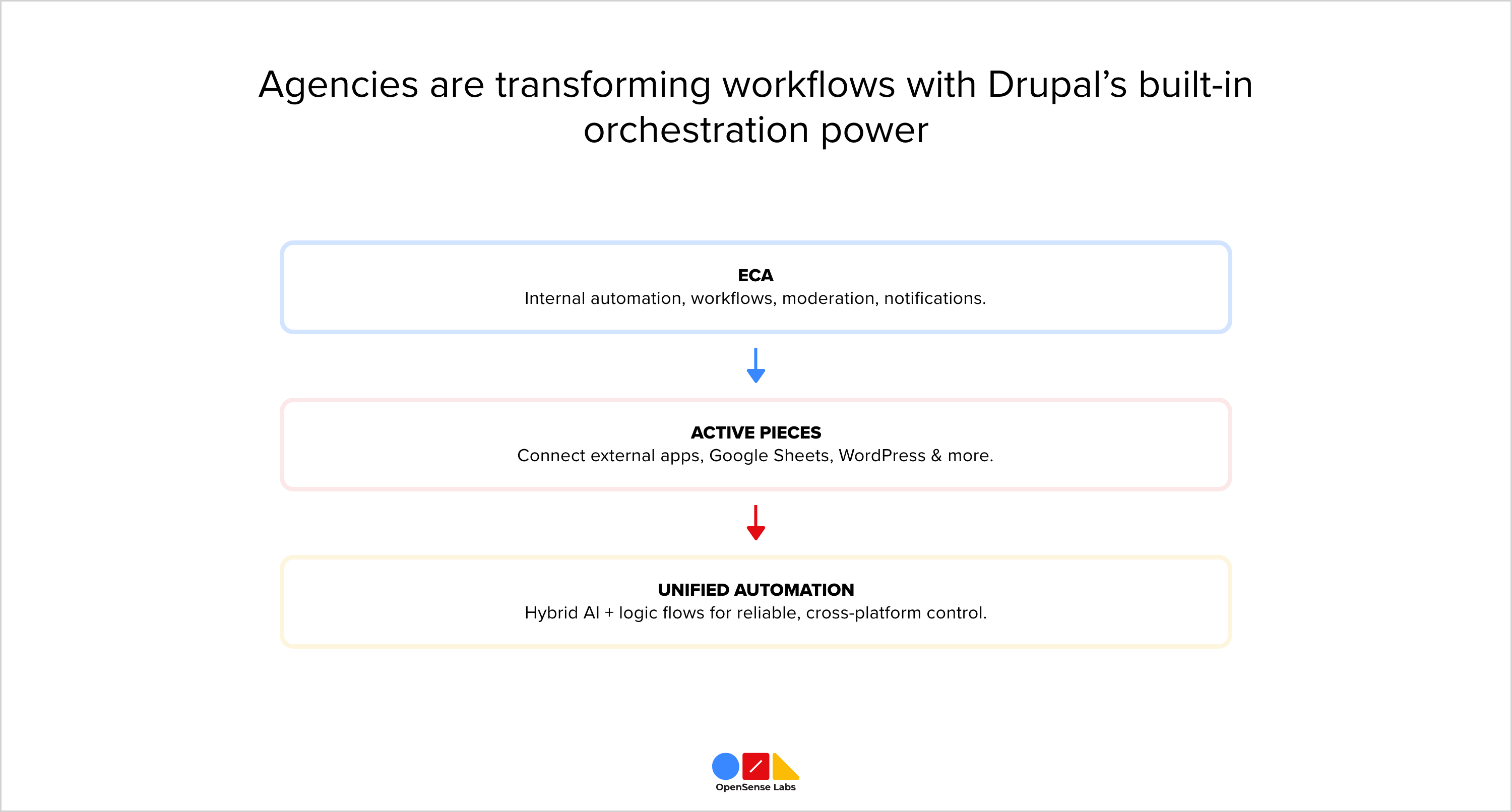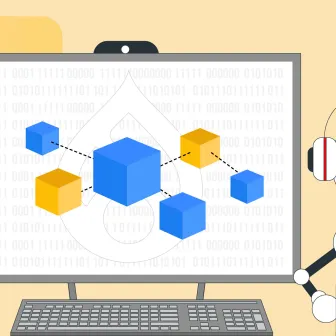DrupalCon Vienna Key Takeaways: Transforming Drupal with AI
AI-TranslatedDries delivered his 43rd keynote at DrupalCon Vienna!
“AI is the storm… but instead of turning away, we need to embrace AI. We need to experiment as much as we can and as fast as we can. And in many ways, that’s the interesting irony, because AI is a storm, but it’s also the way through the storm.” - Dries Buytaert
DrupalCon Vienna 2025 was an important event for the Drupal community, highlighting the platform's impact on the future of digital experiences.
The conference showcased new developments like Drupal Canvas, AI-driven content creation, and orchestration tools such as ECA and Active Pieces.
These advancements improve web development by speeding it up, making it smarter, and easier to reach, all while focusing on human creativity.
The DrupalCon Vienna event showed agencies, enterprises, and developers that Drupal is still a leading platform for building effective, user-focused digital experiences.
In this blog post, we’ll share key highlights from DrupalCon Vienna, explore recent innovations shaping digital experiences, and discuss what they mean for how organizations build and improve their online presence.
If you are thinking about moving from your current CMS to Drupal, or if you want to keep up with AI-driven advancements, check out our services at OpenSense Labs before proceeding with the blog.
Now, let's continue with the DrupalCon Vienna updates!
Drupal Canvas: AI-Powered Page Creation
At DrupalCon Vienna, Dries mentioned that the past 18 months have been the most fruitful time in Drupal's history, with community contributions increasing twofold since 2023.
This momentum stems from the Starshot initiative, designed to make Drupal easier to adopt and more accessible for everyone. One of the key outcomes of this collective effort is Drupal Canvas, a reimagined, visual site builder that brings Drupal’s technical depth and creative usability together.
Canvas is not just a simple add-on like traditional page builders. It is a native Drupal experience designed to help creators, marketers, and businesses create and manage digital experiences more quickly, all while maintaining Drupal's structured and open foundation.
At DrupalCon Vienna, Dries showcased how AI support is smoothly incorporated into Canvas, allowing users to create completely organized, brand-consistent pages in just a few minutes.
What really stood out was the harmony between automation and control. While AI speeds up creation, editors still have the power to review, refine, and customize text, layout, and media, keeping human creativity at the heart of the process.
This marks a significant shift in how digital teams work, with less dependency on developers, faster content turnaround, and more time spent on strategy and storytelling.
In Dries’ words, this isn’t just a new feature; it’s Drupal embracing the future of content creation through AI, while staying true to its open, community-driven DNA.

AI Agents: Future of Background Automation
The Drupal AI Initiative began five months ago and has raised a total of one million dollars in cash and FTE contributions from 22 partners around the globe. OpenSense Labs is proud to be one of the contributors leading this change.
From this initiative, a set of integrated AI tools has been developed to improve site-building and content creation:
- AI Page Generation: This tool allows users to create full landing pages using prompts and set brand guidelines. Drupal Canvas now allows users to create fully structured landing pages straight from prompts and brand settings.
Users can quickly design consistent layouts (reusable content blocks) in just a few minutes, including hero banners, product cards, and testimonial sections.
And with integrated modules like CKEditor, Metatag, and Webform, users can ensure that every page is functional and optimized for SEO, engagement, and conversion.
Also, AI will help in accelerating layout creation, while Drupal’s structured data keeps everything organized and reusable across channels. - Context Control Center: This is a setup interface of the workflow, which makes sure that all produced content matches the brand's voice, messaging, and design consistency.
Using the Mercury theme and content templates, creators can visually adjust page layouts for various view modes, like blogs or product pages, right in the browser, without needing to edit any code. This unified system guarantees that drafts created by AI match the brand's voice, while allowing human teams to assess, improve, and tailor every detail. - Autonomous Drupal Agents: These agents work in the background. They identify updates, highlight inconsistencies, recommend changes, and start drafts with complete audit trails and human review points.
In addition to creation, Drupal Canvas brings automation with Autonomous Drupal Agents, smart systems that operate in the background. These agents detect outdated modules, highlight design issues, recommend layout enhancements, and can even start content drafts while keeping thorough audit records.
By connecting with ECA (Event Condition Action) and external orchestration tools such as Active Pieces, these agents guarantee ongoing optimization and seamless teamwork among teams.
At DrupalCon Vienna, Dries stressed that this is not about total automation. It is about enhancement. AI in Drupal is meant to support the creator, not to take their place. It is the structured foundation of Drupal, along with its revisioning, content modeling, and permissions, that enables this safe integration of AI.
ALSO CHECK OUT
- Drupal AI Ecosystem Part 1: Setup and AI CKEditor Configuration
- Transform Your Website with Drupal AI Module in 2025
- Create and Integrate: CKEditor 5 Plugin in Drupal 11
- Agentic AI Dynamics: Future of Data Retrieval
Mercury Design System: Defining Next-Gen Site Templates
When the user installs Drupal CMS 2.0, the user will see a significant change right away. Instead of picking features or recipes, the user can start with a Site Template.
The first template, named Byte, is tailored for a business-to-business software website and is fully built on the new Mercury design system.
Mercury offers a unified design framework with reusable components, consistent layouts, and accessible visual standards, making sure every site created looks polished from the beginning.
In a minute and with only three clicks, users can create a complete website that includes software pages, pricing details, resources, blogs, and a contact form. It merges the strength of Drupal with user-friendliness.
Byte is only the beginning. Dries revealed plans for a full Site Template Marketplace, overseen by the Drupal Association, with Tiffany Farris and Tim Lennon in charge.
This marketplace will feature both free and paid templates created by Drupal-certified partners, all adhering to strict standards for accessibility, security, documentation, and demo content.
This initiative transforms Drupal from a CMS into a template-based creation system, making it easier for new users and agencies to adopt and lowering the barriers to entry. The long-term vision extends even further: allowing designers to create site templates using no-code tools.
Imagine a designer creating a Drupal site, giving it a visual style, and exporting it as a Site Template that others can use, all without the help of a developer.
As Dries pointed out at DrupalCon Vienna, this could "create a whole new realm for Drupal," expanding its community and creative opportunities.
DrupalCon Vienna: Upcoming Releases & Timeline
The coming months signal a major leap forward in Drupal’s evolution. Dries announced two major milestones that will shape the future of site building and content creation:
- Drupal Canvas 1.0: At present, Drupal Canvas 1.0 is in the release stage, with a full launch expected in November. Canvas offers an easy-to-use visual site builder, AI-powered content creation, and in-browser editing, allowing both technical and non-technical users to create and manage websites with ease.
- Drupal CMS 2.0: Scheduled for early January, this version will make Canvas the standard site-building experience. It redesigns Drupal to improve accessibility and encourage use, simplifying the process for new users while providing greater flexibility for developers and marketers.
Together, these releases mark a new era of usability and adoption for Drupal, one that combines creativity, automation, and structure.
As Dries highlighted at DrupalCon Vienna, Drupal Canvas is a new update that will change the way digital experiences are built on the Open Web.
Drupal Canvas is changing how websites are built, and OpenSense Labs can help you turn that change into an advantage.
Here’s what’s next in Drupal’s evolution!
Workflow: Orchestration Tools for Agencies
At DrupalCon Vienna, Dries highlighted that Drupal has transformed from merely a CMS into a full-fledged orchestration hub for both internal and external workflows, enabling agencies to enhance their operations and increase productivity.
This evolution is fueled by important innovations such as ECA (Event Condition Action) and Active Pieces, which work together to enhance automation both inside and outside of Drupal. The details of these innovations are discussed below:
ECA: Internal Orchestration within Drupal
The Event Condition Action (ECA) module features a user-friendly interface for overseeing workflows, automating content moderation, sending notifications, and running database queries, all without the need for custom coding.
- With over 13,000 sites utilizing ECA, its popularity is clearly on the rise.
- Future UI enhancements will further simplify the process, making it easy for non-developers to design and visualize workflows with ease.
Active Pieces: External Orchestration Beyond Drupal
In addition to ECA, Active Pieces acts as a connector between Drupal and other platforms such as WordPress, Google Sheets, and various project management tools.
- It allows for hybrid automation processes, combining AI-driven insights with fixed logic for reliable and scalable task automation.
- This integration ensures that Drupal remains adaptable in multi-platform environments, which is perfect for agencies managing different digital settings.
The Power of Synergy
By integrating ECA’s internal orchestration with Active Pieces’ external connections, Drupal provides agencies with a comprehensive workflow automation solution.
This synergy allows teams to automate intricate processes from content approvals and marketing triggers to data synchronization while ensuring accuracy, control, and adaptability.

Open Web Revolution: Drupal’s Path Forward
Dries wrapped up his speech at DrupalCon Vienna by reaffirming Drupal’s long-standing dedication to the Open Web as a realm founded on transparency, inclusivity, and user freedom. As digital experiences become more AI-driven, he also mentioned that websites will continue to be central to how users engage, learn, and generate value online.
In this new age, Drupal seeks to empower creators, marketers, and developers to craft experiences that are not only functional but also meaningful and centered around human needs. The vision is straightforward:
- Encourage high-quality content that educates and inspires, rather than content merely designed for clicks or algorithms.
- Provide outstanding user experiences (UX) that honor privacy and accessibility, keeping control with users and creators.
- Creators fairly compensate, ensuring that open-source innovation flourishes outside the limits of closed systems.
As AI transforms the web, Drupal is ready to lead as the most flexible, transparent, and community-focused platform for AI-enhanced content management and digital experience creation.
These updates show that Drupal is evolving into a faster, smarter, and more collaborative platform for building the open web.
ALSO CHECK OUT
- Back from DrupalCon Atlanta 2025: A Milestone Moment for OpenSense Labs
- DrupalCon Singapore: It’s A Wind Up For 2024
- DrupalCon Barcelona: 2024 Wrap-Up From Europe
- Ahoy Prague! Attending First DrupalCon
Key Takeaways
- Drupal is responsibly adopting AI, merging automation with human creativity through tools like Drupal Canvas and Autonomous Drupal Agents.
- Site Templates and the Mercury Design System are making site-building easier, allowing for the quick launch of visually consistent, accessible websites.
- The new orchestration tools, ECA and Active Pieces, turn Drupal into a complete workflow hub, allowing agencies to automate processes both inside and outside of Drupal effortlessly.
- AI-driven innovation aligns with accessibility, with Drupal CMS 2.0 and Canvas 1.0, the platform becomes more user-friendly for marketers, designers, and non-developers.
- Drupal’s future is based on the Open Web, focusing on transparency, inclusivity, ethical AI, and rewarding creators, ensuring that technology continues to benefit people.
Abonnieren
Verwandte Blogs
Drupal KI-Ökosystem Teil 1: Einrichtung und KI CKEditor Konfiguration

Die Drupal KI-Module integrieren künstliche Intelligenz nahtlos in das Drupal-Ökosystem und betrachten KI als fundamentalen…
Transformieren Sie Ihre Website mit dem Drupal AI Modul 2025

Drupal macht schnelle Fortschritte im Bereich der Künstlichen Intelligenz – mit der Entwicklung des Drupal AI Modules und…
Gin Admin Theme: Claro im Drupal CMS ersetzen

Drupals Standard-Admin-Theme, Claro, ist einer der Faktoren, die einen visuellen Vergleich zwischen Drupal 7 und Drupal 10…




